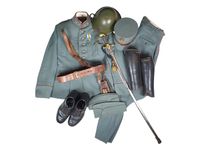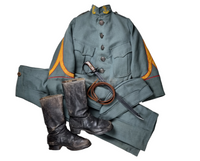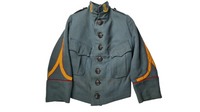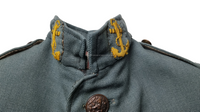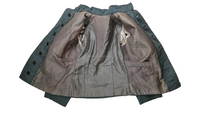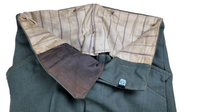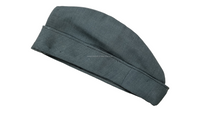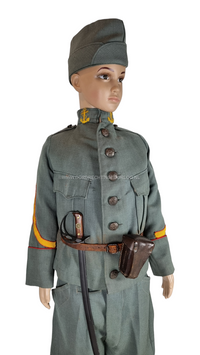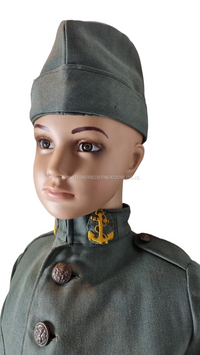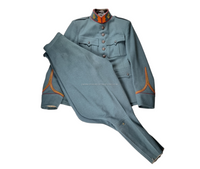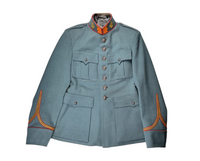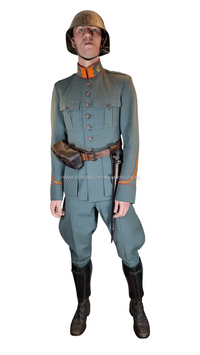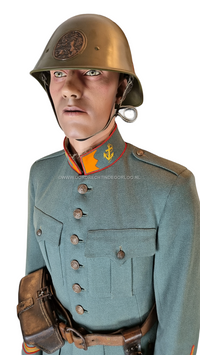Uniforms of the "Korps Pontonniers and Torpedisten".
The Pontonniers Uniform:
Below you can see a Pontonniers uniform from the mobilization period in the Netherlands. It is a field gray jacket with the characteristic anchor emblem of the Pontonniers displayed on the collar, along with two red trims above and below it. The two stars on either side indicate that the jacket belonged to a First Lieutenant of the Pontonniers. The jacket has four pockets, and the fabric clearly shows that it is an outer cut uniform, as opposed to the coarser wool uniform typically worn by enlisted personnel and often by non-commissioned officers.
Officers were entitled to a reimbursement for the purchase of an "buitenmodel" uniform. They also had a higher salary to cover the costs of such a purchase. This is one of the reasons why there are still many "buitenmodel" uniforms found today, while there are very few coarse wool uniforms. The latter had to be turned in by Dutch soldiers during the occupation and were eagerly reused and converted by the Germans into German-style uniforms. The "buitenmodel" uniforms often remained in private possession. This jacket is an example of that. Unfortunately, the jacket does not have a name attached to it. In the photos below, two display options can be seen: one with the field gray cap and one with a helmet. In many cases, officers could also wear a kepi.
The field gray cap with gold trim was for officers and was the same for every service branch or specialty. The cap features an Orange Lion emblem.
The next photo shows the Dutch helmet with its characteristic lion plate. The helmet was generally the same for all soldiers and did not have any characteristic features indicating the rank of an officer, as can sometimes be seen in other countries. The helmet would be worn in combat situations. Additionally, a "Sam Brown" belt with saber or cutlass carrier can be seen. The belt was designed for officers and was of the same model as those worn by British officers. The saber or cutlass carrier, as the name suggests, provided a place to carry a saber or cutlass.
Update May 12, 2020:
We have successfully set up a complete mannequin. Below are the photos:
The mannequin represents a First Lieutenant of the Corps of Pontonniers and Torpedisten in May 1940. In the first four photos, he is wearing his combat helmet. The lieutenant has inserted a map of Dordrecht into his left breast pocket. Over his uniform, he is wearing the standard "Sam Brown" belt worn by officers of the pre-war Dutch army. Attached to the belt, he has various items. Firstly, his M25 pistol holster, which would normally contain the FN Browning pistol. This was a standard weapon among Dutch officers as well as non-commissioned officers. Pontonnier officers were often equipped with older revolvers. Next to his holster is the magazine pouch, which holds two magazines. On his hip, he carries the cutlass ( Klewang ) . Although this weapon was primarily used within the Royal Dutch East Indies Army (KNIL) as a means of navigation through the jungle, the cutlass had a more traditional character in the European Dutch army. Nevertheless, during the May 1940, many Dutch officers and non-commissioned officers wore the cutlass. There is even a story known of a Dutch soldier who used it to fight German soldiers here on the Grebbeberg.
Upon closer examination, we can see that the trousers have a different color than the jacket, which was not uncommon. Usually, the outer cut uniform was purchased as a set, and its color would match. However, the trousers were often subject to more wear and tear, which sometimes required the purchase of additional trousers. It was not always guaranteed that the same color trousers could be acquired. These trousers also have a red trim, just like the jacket, which is customary for officers. The lieutenant is wearing gaiters over his trousers, while enlisted personnel typically wore puttees or leg wraps. Beneath his gaiters, we see black shoes. These were often privately purchased by the soldiers, for which they received a reimbursement.
In the photos below, you can see that the officer has exchanged his helmet for his field cap. Additionally, he is holding an open pack of Dutch Amateur cigarettes in one hand. In the other hand, he is holding one of the cigarettes. The mobilization period was a time when almost every adult man smoked, either a pipe or cigarettes.
Update July 22, 2021:
Several adjustments have been made to the composition of the above mannequin. A study of various photos of the Corps of Pontonniers and Torpedisten revealed that the (sub)officers of this corps were generally equipped with the M1873 revolver instead of the M25 pistol. Therefore, the M25 holster set has been replaced with an M1873 revolver set. Additionally, a gas mask pouch with a gas mask (Type G) has been added to the mannequin. Finally, a camera and a pair of glasses have been included to enhance realism. You can find the photos below.
First Lieutenant, Corps of Pontonniers and Torpedistsen.
Here you can find the uniform of a First Lieutenant of the Corps of Pontonniers and Torpedisten. The uniform has some differences compared to the First Lieutenant previously posted on this page. The jacket, trousers, two peak caps, and kepi all belonged to the same person. The shoes, gaiters, belt, saber, and helmet have been added to complete the ensemble.
The jacket still has a name label, but unfortunately, the name is no longer readable. The First Lieutenant of the Corps of Pontonniers and Torpedisten depicted at the top of the page is equipped for field or combat. With this uniform, the choice has been made to depict a wearing style for a more ceremonial occasion. Interestingly, the uniform is quite large in size. While it is usually a problem to fit Dutch uniforms on a mannequin, this uniform is actually still a bit too big. This is not common for Dutch uniforms, suggesting that the wearer of the uniform was a large man for his time. For the portrayal of the uniform, a photo from the image bank of the Regional Archive Dordrecht was used as inspiration: This photo shows the command transfer from Lieutenant-Colonel Valliant to Lieutenant-Colonel Mussert at the Pontonniers barracks. See the photo.
On the right side of that photo, there is a First Lieutenant of the Corps of Pontonniers and Torpedisten with a saber in hand. He is wearing the so-called "Jeneverkruis" - a medal for faithful service for officers.
The first three photos above provide a nice representation of the First Lieutenant wearing his "Kepie". The Corps of Pontonniers and Torpedisten did not have a regimental number on the cap. Instead, they wore a Dutch lion on the cap or side cap. The officer wearing the saber on the officer's belt is carrying a Yzerhouwer saber. The Klewang sword was generally worn in the field and also during May 1940, while the saber was worn more for ceremonial occasions.
On the chest of the uniform, there is an Officer's Cross for faithful service. In this case, it represents 25 years of service. The cross was also known as the "Jeneverkruis" because, traditionally, a glass of Jenever (a Dutch liquor) was shared during its presentation. The fourth photo shows the officer wearing his helmet. This photo indeed bears the most resemblance to the photo from the regional archive. In the photos below, a closer look is taken at the jacket and cap. Here, you can clearly see the two stars on the collar of the jacket, indicating the rank of First Lieutenant, as well as the anchors of the Corps of Pontonniers and Torpedisten.
Children's uniform Corps of Pontonniers and Torpedistsen.
This special uniform was created during the mobilization period for a child. It was completely crafted in the same way as the daily uniform made for Dutch soldiers during the mobilization. It consists of a full set with a jacket, pants, and a hat. The jacket features two chest pockets and what are known as "banana peels" on the sleeves indicating the rank of sergeant. The jacket is adorned with the same Dutch lion buttons as found on a pre-1940 Dutch military uniform. Non-commissioned officer emblems of the Army Maritime Engineer Corps are added to the collar. Even the pants are tailored in the same style as the daily uniform that was custom made by tailors to a standard model.
The uniform is particularly unique because it is very rare. A daily uniform was not exactly cheap to acquire during the mobilization period. It could cost between 40 and 60 gulden back in the day. Officers received an allowance to purchase such a uniform, but a soldier who had one made for their child, perhaps with the intention of playing in it, must have had a very good income for that time. In the photos below, we see the uniform on a child mannequin. It should give an idea of what it have looked like during that time.
Uniform W. de Vries-Lentsch.
This is the uniform of Willem de Vries-Lentsch. It is an uniform of the Corps of Pontonniers and Torpedists. (Army Maritime Engeneers) Intended for a sergeant at the School for Reserve Officers (SRO). The uniform has red piping on the collar and sleeves, and embroidered emblems of a fouled anchor on the collar. The orange SRO collar patches are also visible on the uniform. On the sleeves, so-called banana peels are applied. These are rank insignia for the rank of sergeant. The uniform is named after W. de Vries-Lentsch.
Willem de Vries-Lentsch (Jr) was born on May 31, 1919, in Nieuwendam. He was the son of Willem de Vries-Lentsch (Sr) and Elizabeth Schreuder. Willem came from a family of renowned boat builders. His father also won a bronze medal in the "Star" class at the 1936 Olympic Games in Berlin. Willem himself would compete in the 1948 Olympic Games. On September 18, 1939, Willem was called up as a conscript from the 1939 draft from Amsterdam. He was assigned to the Corps of Pontonniers and Torpedists, where he began training as a reserve officer. On December 2, 1939, Willem was promoted to corporal, and on March 2, 1940, to titular sergeant. Sergeant de Vries-Lentsch served during the mobilization in Dordrecht. He was assigned to the 3rd Depot Company of Pontonniers, stationed at the Benthien Barracks. On May 10, 1940, around 4:00 AM, the soldiers at the Benthien Barracks were awakened by fire from the anti-aircraft machine gun platoons at the Zwijndrecht bridges. Shortly thereafter, the first German paratroopers would land, and the first battles would break out in the city. Around 6:00 AM, Sergeant de Vries-Lentsch was assigned to a group of pontonniers under the command of Lieutenant Over. The group consisted of four sergeants: J. Wiesman, G.D. Hoeksema, Q. Groenwegen, and W. de Vries-Lentsch.
Willem de Vries-Lentsch in post-war uniform.
There were also about 7 to 8 soldiers assigned to the group, and the truck was driven by Pontonnier Lijn Nijenkamp. The group was tasked with reinforcing the bridge guard, and while Lieutenant Over sat next to the driver, the rest sat in the truck bed at the back. Although the distance to the bridges was not far as the crow flies, the truck had to detour via the Spuitunnel under the railway and the Vlietweg due to the length and location of the bridge ramp. Things went wrong at the Marnixstraat when the truck turned into the street. When one of the tires was shot flat, the truck tipped over, causing the men to be thrown out. Miraculously, only one soldier was injured: Private Koole, who later died in the hospital. The soldiers had their bayonets fixed to their weapons and landed on top of each other when the truck tipped over. It was a stroke of luck that no one else was injured.
Meanwhile, the group, seeking as much cover as possible, moved into Marninxstraat towards the Vlietweg. There, they again encountered German paratroopers. On the Vlietweg, houses were being built, and the Pontonniers spread out in the houses under construction. Lieutenant Over took cover in a tall sewer pipe but was soon hit and died within minutes from his injuries. Conscripted private Develing was also killed, and conscripts Bruins and Van Ham were wounded. Suddenly, three Germans stood behind Sergeant de Vries-Lentsch, shouting for him to drop his carbine. There was nothing left to do but surrender. Sergeants Wiesman, Groenewegen, and several soldiers were taken along with de Vries-Lentsch to the Zwijndrecht bridges, while the wounded and dead were left behind. There, they joined the captured soldiers of the two anti-aircraft machine gun platoons.Soon, the prisoners were moved to Zwijndrecht, where they were forced to build breastworks and dig trenches to control the road to Rotterdam.
On the afternoon of May 10, 1940, Willem de Vries-Lentsch and the other prisoners were moved to the Christian school on the Admiraal de Ruyterweg. The prisoners of war were housed on the upper floor of the school, while the Germans occupied the ground floor and set up some rooms as a dressing station. On the afternoon of May 11, 1940, German reinforcements arrived at the school and moved towards Moerdijk via the Rijksweg. They forced the Dutch prisoners of war to walk in front and jumped out when they encountered Dutch posts. As a result, Dutch soldiers were repeatedly captured because there was nothing they could do about it. Meanwhile, many prisoners of war were wounded, unable to move, and caught in the crossfire. After the Germans repeated this tactic several times, they returned to the school with prisoners. The next day, on May 13, the school was shelled by Dutch artillery fire. Many were seriously wounded, including civilians, and there were several fatalities. The following day, Willem de Vries-Lentsch and other prisoners of war had to bury the dead. There were ten Dutch and ten Germans.
On May 14, the white flag waved on the tower of the Grote Kerk in Dordrecht. The battle in Dordrecht was over. The Dutch army had retreated to Papendrecht. The prisoners of war from the school were marched towards Rijsoord. In Barendrecht, they were joined by other prisoners, where they stayed until May 17. After that, they returned to Dordrecht. Here, Willem de Vries-Lentsch rejoined the other Pontonniers at the Benthien Barracks. He stayed there until June 11, when he went on extended leave.
In the report of the May days of 1940, you can read more about the experiences of Willem de Vries-Lentsch during the first days of the war. Sadly it's written in Dutch but we have added it anyway.
The uniform of Willem de Vries-Lentsch.
The uniform on a mannequin:
©2017-2025 :Https://www.Dordrechtindeoorlog.nl: ( There is a copyright on the content of this website. This content is not to be shared, duplicated or published withouth the explicit permission of the author of this website. If you have any requests you can email to: Info@Dordrechtindeoorlog.nl or look on : www.dordrechtindeoorlog.nl/termsofuseforthecontentonthiswebsite.















